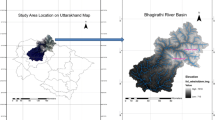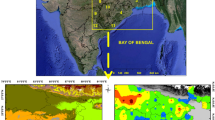Abstract
The total precipitation of the highest 1 day, 3 day, 5 day and 7 day precipitation amount (R1D, R3D, R5D and R7D) in the Yangtze River basin was analyzed with the help of linear trend analysis and continuous wavelet transform method. The research results indicated that: 1) Spatial distribution of R1D is similar in comparison with that of R3D, R5D and R7D. The Jialingjiang and Hanjiang river basins are dominated by decreasing trend, which is significant at >95% confidence level in Jialingjiang River basin and insignificant at >95% confidence level in Hanjiang River basin. The southern part of the Yangtze River basin and the western part of the upper Yangtze River basin are dominated by significant increasing trend of R1D extreme precipitation at >95% confidence level. 2) As for the R3D, R5D and R7D, the western part of the upper Yangtze River basin is dominated by significant increasing trend at >95% confidence level. The eastern part of the upper Yangtze River basin is dominated by decreasing trend, but is insignificant at >95% confidence level. The middle and lower Yangtze River basin is dominated by increasing trend, but insignificant at >95% confidence level. 3) The frequency and intensity of extreme precipitation events are intensified over time. Precipitation anomalies indicated that the southeastern part, southern part and southwestern part of the Yangtze River basin are dominated by positive extreme precipitation anomalies between 1993–2002 and 1961–1992. The research results of this text indicate that the occurrence probability of flash flood is higher in the western part of the upper Yangtze River basin and the middle and lower Yangtze River basin, esp. in the southwestern and southeastern parts of the Yangtze River basin.
Similar content being viewed by others
References
Allen M R, Smith L A, 1996. Monte Carlo SSA: detecting irregular oscillations in the presence of coloured noise. Journal of Climatology, 9: 3373–3404.
Changjiang Water Resources Commission, Ministry of Water Resources (CWRC). Waterlogging and Aridity Disasters in the Yangtze River Basin. Beijing: China WaterPower Press, 2002. (in Chinese)
Easterling D R, Meehl G A, Parmesan C et al., 2002. Climate extremes observations, modelling, and impacts. Science, 289: 2068–2074.
Farge M, 1992. Wavelet transform and their application to turbulence. Annu. Rev. Fluid Mech., 24: 395–457.
Fowler A M, Hennessy K J, 1995. Potential impacts of global warming on the frequency and magnitude of heavy precipitation. Natural Hazards, 11: 283–303.
Grinsted A, Moore J C, Jevrejeva S, 2004. Application of the cross wavelet transform and wavelet coherence to geophysical time series. Nonlinear Processes in Geophysics, 11: 561–566.
Groisman P Y, Karl T, Easterling D et al., 1999. Changes in the probability of the heavy precipitation: important indicators of the climate change. Climate Change, 42: 243–283.
Hewitson B C, 1997. A methodology for developing regional climate change scenarios from general circulation models. WRC Report No. 594/1/97, 35p.
Horton E B, Folland C K, Parker D E, 2001. The changing incidence of extremes in worldwide and central England temperatures to the end of the twentieth century. Climate Change, 50: 67–295.
Jones C, Waliser E D, Lau M K et al., 2004. Global occurrence of extreme precipitation and the Madden-Julian oscillation: observations and predictability. American Meteorological Society, 17: 4575–4589.
Karl T R, Knight R W, Plummer N, 1995. Trends in high-frequency climate variability in the twentieth century. Nature, 377: 217–220.
Katz R W, Brown B G, 1992. Extreme events in a changing climate: variability is more important than average. Climatic Change, 21: 289–302.
Labat D, Goddéris Y, Probst J L et al., 2004. Evidence for global runoff increase related to climate warming. Advances in Water Resources, 27: 631–642.
Lucero A O, Rozas D, 2002. Characteristics of aggregation of daily rainfall in a middle-latitudes region during a climate variability in annual rainfall amount. Atmospheric Research, 61: 35–48.
Mora R D, Bouvier C, Neppel L et al., 2005. Regional approach for the estimation of low-frequency of low-frequency distribution of daily rainfall in the Languedoc-Roussillon region, France. Hydrol. Sci. J., 50(1): 17–29.
Plummer N, James M, Neville S et al., 1999. Changes in climate extremes over the Australian region and New Zealand during the twentieth century. Climate Change, 42: 183–202.
Su B D, Jiang T, 2005a. Recent trends in temperature and precipitation extremes in the Yangtze River basin, China. Theoretical and Applied Climatology, DOI 10.1007/s00704-005-0139-y.
Su B D, Xiao B, Zhu D M et al., 2005b. Trends in frequency of precipitation extremes in the Yangtze River basin, China: 1960–2003. Hydrol. Sci. J., 50(3): 479–492.
Suppiah R, Hennessy K, 1996. Trends in the intensity and frequency of heavy rain in tropical Australia and links with the southern oscillation. Austr. Met. Magazine, 45: 1–17.
Torrence C, Compo G P, 1998. A practical guide to wavelet analysis. Bulletin of American Meteorological Society, 79: 61–78.
Zar J H, 1999. Biostatistical Analysis. Old Tappan, N. J.: Prentice-Hall.
Zhai P M, Sun A J, Ren F M, 1999. Changes of climate extremes in China. Climatic Change, 42(1): 203–218.
Zhang Q, Jiang T, Germmer M et al., 2005. Precipitation, temperature and discharge analysis from 1951 to 2002 in the Yangtze River basin, China. Hydrological Sciences Journal, 50(1): 65–80.
Zhang Q, Liu C L, Xu C Y et al., 2006. Observed trends of annual maximum water level and streamflow during past 130 years in the Yangtze River basin, China. Journal of Hydrology, 324: 255–265.
Author information
Authors and Affiliations
Additional information
Foundation: Funded by the Nanjing Institute of Geography and Limnology, CAS, No.S260018; The Chinese Meteorological Administration, No.ccsf2006-31
Author: Zhang Zengxin (1977–), Ph.D. Candidate, specialized in climatic changes.
Rights and permissions
About this article
Cite this article
Zhang, Z., Zhang, Q. & Jiang, T. Changing features of extreme precipitation in the Yangtze River basin during 1961–2002. J GEOGR SCI 17, 33–42 (2007). https://doi.org/10.1007/s11442-007-0033-x
Received:
Accepted:
Issue Date:
DOI: https://doi.org/10.1007/s11442-007-0033-x




